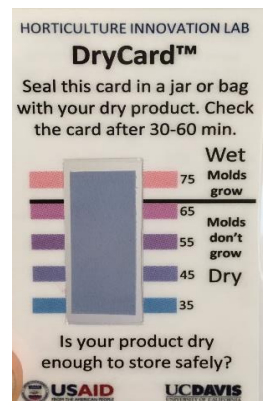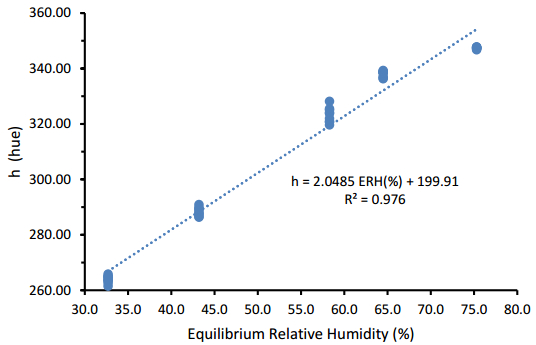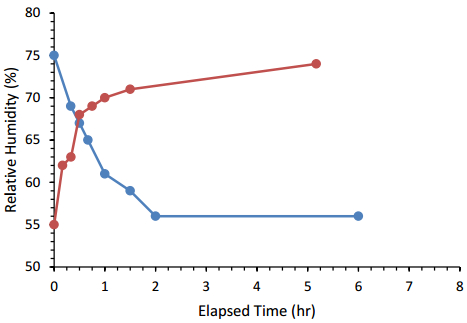1. Introduction
The storage life and safety of dried products such as grains, pulses, and dried fruits, vegetables and meat, is closely related to their water activity. Water activity (Aw) is the headspace relative humidity, expressed as a decimal, within a hygroscopic material. It is also termed equilibrium relative humidity (ERH). At typical storage temperatures (15–25 ℃ in temperate and high elevation tropical areas and 25–35 ℃ in the humid tropical areas), an Aw of 0.65 or less will prevent the growth of most fungi and particularly toxigenic fungi [1]. Contaminating fungi may consume dry weight, cause off-flavors, and most importantly may produce toxins. Alfatoxin, a mycotoxin primarily produced by Aspergillus flavus and Aspergillus parasiticus, accumulates rapidly in inadequately dried products and contaminates large amounts of the maize and groundnuts consumed in Africa. Consumption of aflatoxin-contaminated food causes malnutrition-related stunting, and, at high contamination levels, liver cancer and acute poisoning [2]. Instrumentation is available for direct measurement of Aw, but the least costly devices exceed USD 2000. Electronic hygrometers have been proposed as a method of measuring headspace relative humidity and estimating Aw, but most of the least expensive devices cannot be adjusted to read calibrated humidity [3,4].
Cobalt chloride humidity paper was invented in 1945 to determine relative humidity around stored products [5]. Cobalt chloride changes color from sky blue in its anhydrous form, to mauve in partial hydration and purple when completely hydrated as a hexahydrate. When incorporated into a cellulose medium, the color of the paper can be used to indicate the relative humidity of the air surrounding it [3,6]. Relative humidity indicating paper has been sold commercially for decades and is currently available from several sources. The humidity paper is reusable. We have developed a convenient package for the paper called DryCard (Figure 1). A short strip of the humidity paper and instructions for using the card are laminated in a business card-sized PET-EVA plastic pouch. A window is cut in one side of the lamination to allow the humidity paper to have direct access to its surrounding environment. The card is reusable and can be manufactured in quantity for less than USD 0.05 in materials cost, using inexpensive (< USD 20.00) laminating machines. The object of this article is to evaluate the color response and response time of commercially available humidity indicator paper—incorporated into the DryCard format.
2. Materials and Methods
Three strips, each 3 cm long, of cobalt chloride humidity paper (Micro Essential Lab, Brooklyn, NY) were laminated on one side to PET-EVA plastic. The plastic was taped to the underside of a flat sheet of plastic, sized to fit over a Petri dish. For the color response test, six dishes were filled with about 10 g each of a range of salts (Table 1). Enough distilled water was added to the salt to wet the entire mass and still leave undissolved crystals. The samples were placed in an insulated cooler containing two sealed 2 L containers of water to minimize temperature fluctuation and equilibrated for 24 hours. The test was conducted at 22–23 ℃, which represents a midpoint between the temperature extremes of temperate and humid climates. Expected equilibrium relative humidity for the different salts were obtained from the tables in [7], except for sodium nitrite [8]. The color of each of the three strips was measured with a ColorFlex EZ spectrophotometer (Hunter Lab, Reston, VA) and expressed in the Commission Internationale de l'Eclairage (CIE) L*C*h color coordinates, corresponding to L* = lightness, C* = chroma, and h = hue. The test was repeated on three separate days.
Table 1. Headspace equilibrium relative humidity above saturated salts used the in the study.
| Salt |
Relative humidity (%) above saturated salt |
| Potassium chloride |
84.7 |
| Sodium chloride |
75.3 |
| Sodium nitrite |
64.5 |
| Sodium bromide |
58.3 |
| Potassium carbonate |
43.2 |
| Magnesium chloride |
32.7 |
Response time was evaluated by placing the laminated strips over Petri dishes of sodium bromide salt (58.3% RH) and allowed to equilibrate for 24 hours. At the start of the test, the color of one set of three strips was measured. The plastic sheets with the laminated humidity strips were then carefully slid over neighboring Petri dishes containing saturated sodium chloride. The NaCl (75.3% RH) dishes had been covered with an extension of the plastic sheet with the affixed humidity strips for 24 hours to allow the headspace humidity to equilibrate. Following the transfer, the color of the replicate humidity strips was periodically measured. Sets were not reused until headspace humidity had re-equilibrated (several hours). The test was repeated with the strips first equilibrated with NaCl (75.3% RH) and then exposed to NaBr (58.3% RH).
3. Results and Discussion
A multiple linear regression model analysis-of-variance of data from RH = 32.7 to 75.3% (Table 2), indicated that the color response was associated with changes in h value (p < 0.05). L* and C* values did not make a significant improvement (p > 0.05) to the multiple regression model. Color response changed linearly (R2= 0.98) up to a relative humidity of about 75% (Figure 2). There was only a small difference in h between 84.7 and 75.3% RH (Table 2). The color of the paper was visually different between all humidity levels except between the 84.7 and 75.3%. In many practical situations, users need only to know whether the headspace RH is above or below the 65% threshold for fungal growth and the paper clearly is useful for his purpose. Humidity paper is available with other chemistries that have color differences at relative humidity levels above 75% [Clariant, Colton, CA, USA]. Many of these chemistries do not use cobalt chloride which is classified as a substance of very high concern by the European Chemicals Agency [9]. However, cobalt chloride humidity paper is currently sold in the EU.
Table 2. Mean and ± standard error for color response of cobalt chloride humidity paper with varying relative humidity levels.
| Salt |
RH (%) |
L* |
C* |
h |
| KCl |
84.7 |
68.1 ± 0.5 |
29.5 ± 0.1 |
349.2 ± 0.3 |
| NaCl |
75.3 |
71.0 ± 0.1 |
30.1 ± 0.2 |
347.3 ± 0.1 |
| NaNO2 |
64.5 |
71.3 ± 0.1 |
27.6 ± 0.3 |
338.0 ± 0.4 |
| NaBr |
58.3 |
71.2 ± 0.1 |
24.4 ± 0.4 |
323.3 ± 0.9 |
| KCO3 |
43.2 |
68.5 ± 0.1 |
23.1 ± 0.1 |
288.3 ± 0.5 |
| MgCl |
32.7 |
67.1 ± 0.1 |
25.6 ± 0.1 |
263.9 ± 0.4 |
|
Average |
69.4 ± 0.2 |
26.9 ± 0.4 |
320.0 ± 4.2 |
The response time of the laminated humidity paper was 2 hours when the paper was losing moisture and exceeded 2 hours when it was gaining moisture (Figure 3). Solomon described a response time of 30 minutes and Miyauchi measured response times of 10 to 20 minutes [5,6]. The longer response time in our experiments is expected because the CoCl2 strips are laminated to plastic so only one side is exposed to headspace conditions. Tubbs used electronic hygrometers to measure headspace relative humidity and found response times of 30 to 45 minutes [4].
In practical use, there are many situations where meaningful results can be obtained in 20 to 30 minutes. For example, in humid areas where improperly dried grain is a significant problem, the card will often be equilibrated with a high relative humidity. If the dried product is dry enough to have a 55% ERH (0.55 Aw), then a user would see the color drop below the 65% ERH threshold in 40 minutes. We also observed that the edges of the paper responded faster than the center of the paper and the user may be able to detect a color below the 65% ERH threshold even faster by observing edge color.
Cobalt chloride is deliquescent and we observed that if humidity paper is exposed to saturated conditions, it will gain enough moisture to form liquid water. This redistributes cobalt chloride on the paper and changes the color response of the paper. Allowing liquid water to contact the strip has the same effect. The DryCard should be stored in a plastic bag with a small amount of well-dried grain to keep it adequately dry.
Measuring headspace relative humidity of products during the drying process is time consuming. Meaningful measurements can only be taken after the product has reached internal moisture equilibrium. It is the authors experience that this can take several hours for small grains like rice. Drying in the open sun is common in developing countries. After drying ceases each evening, product is usually bagged and stored in a protected area. Placing a DryCard in the bagged grain during overnight storage should allow adequate time for moisture equilibration and accurate ERH measurement.
In many situations, the microbial safety of dried commodities is described in terms of moisture content [5,9]. Moisture content can be approximated using ERH and product temperature with the aid of published relationships between the variables. However, microbial safety is related directly to Aw without the need to consider product temperature and the DryCard directly measures Aw. Also, Aw-temperature-ERH data are not available for many developing-world dried foods. Producers, handlers and consumers in the developing world can use DryCard to ensure their crops are adequately dried.
4. Conclusions
The DryCard had a consistent color response to relative humidity in the range of 32.7 to 75.3%. Above 75.3% the color change was small. Complete response to a change in relative humidity was two hours or more, although in practical use the card can be used to more rapidly detect product that exceeds the 65% (Aw = 0.65) threshold for fungal growth. The DryCard is a low-cost method that allows producers, handlers and consumers to ensure their dried foods are adequately dried and will not support fungal growth.
Acknowledgement
This work was partially funded by the United States Agency for International Development through the Horticultural Innovation Laboratory at the University of California, Davis.
Conflicts of Interest
Bertha Mjawa has begun commercial production of DryCard in Tanzania. All other authors declare no conflicts of interest.










 DownLoad:
DownLoad: 







